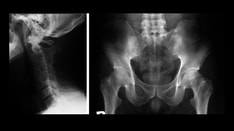Duplechain A, Conrady CD, Patel BC, Baker S. Uveitis. StatPearls. 2022 Jan. [QxMD MEDLINE Link]. [Full Text].
Chauhan K, Tripathy K. Pars Planitis. StatPearls. 2022 Jan. [QxMD MEDLINE Link]. [Full Text].
Kimura SJ, Hogan MJ. Chronic Cyclitis. Arch of Ophthalmol. 1964. 71:193-201.
Raja SC, Jabs DA, Dunn JP, et al. Pars Planitis: Clinical Features and Class II HLA Associations. Ophthalmology. 1999. 106 (3):594-599. [QxMD MEDLINE Link].
Malinowski SM, Pulido JS, Folk JC. Long-term visual outcome and complications associated with pars planitis. Ophthalmology. 1993 Jun. 100(6):818-24; discussion 825. [QxMD MEDLINE Link].
Henderly DE, Haymond RS, Rao NA, et al. The significance of the pars plana exudate in pars planitis. Am J Ophthalmol. 1987 May 15. 103(5):669-71. [QxMD MEDLINE Link].
Rodriguez A, Calonge M, Pedroza-Seres M, et al. Referral Patterns of Uveitis in a Tertiary Care Center. Archives of Ophthalmology. 1996. 114 (5):593-599. [QxMD MEDLINE Link].
Kaplan HJ. Intermediate Uveitis (Pars Planitis, Chronic Cyclitis)- A Four Step Approach to Treatment. Saari KM, ed. Uveitis Update. Amsterdam: Exerpta Medica; 1984. 169-172.
Hogewind BF, Zijlstra C, Klevering BJ, et al. Intravitreal triamcinolone for the treatment of refractory macular edema in idiopathic intermediate or posterior uveitis. Eur J Ophthalmol. 2008 May-Jun. 18(3):429-34. [QxMD MEDLINE Link].
Murphy CC, Greiner K, Plskova J, et al. Cyclosporine vs tacrolimus therapy for posterior and intermediate uveitis. Arch Ophthalmol. 2005 May. 123(5):634-41. [QxMD MEDLINE Link].
Jaffe GJ, Dick AD, Brézin AP, Nguyen QD, Thorne JE, Kestelyn P, et al. Adalimumab in Patients with Active Noninfectious Uveitis. N Engl J Med. 2016 Sep 8. 375 (10):932-43. [QxMD MEDLINE Link].
Nguyen QD, Merrill PT, Jaffe GJ, Dick AD, Kurup SK, Sheppard J, et al. Adalimumab for prevention of uveitic flare in patients with inactive non-infectious uveitis controlled by corticosteroids (VISUAL II): a multicentre, double-masked, randomised, placebo-controlled phase 3 trial. Lancet. 2016 Sep 17. 388 (10050):1183-92. [QxMD MEDLINE Link].
Markomichelakis NN, Theodossiadis PG, Pantelia E, et al. Infliximab for chronic cystoid macular edema associated with uveitis. Am J Ophthalmol. 2004 Oct. 138(4):648-50. [QxMD MEDLINE Link].
Rajaraman RT, Kimura Y, Li S, et al. Retrospective case review of pediatric patients with uveitis treated with infliximab. Ophthalmology. 2006 Feb. 113(2):308-14. [QxMD MEDLINE Link].
Devenyi RG, Mieler WF, Lambrou FH, et al. Cryopexy of the vitreous base in the management of peripheral uveitis. Am J Ophthalmol. 1988 Aug 15. 106(2):135-8. [QxMD MEDLINE Link].
Park SE, Mieler WF, Pulido JS. 2 peripheral scatter photocoagulation for neovascularization associated with pars planitis. Arch Ophthalmol. 1995 Oct. 113(10):1277-80. [QxMD MEDLINE Link].
Becker M, Davis J. Vitrectomy in the treatment of uveitis. Am J Ophthalmol. 2005 Dec. 140(6):1096-105. [QxMD MEDLINE Link].
Quinones K, Choi JY, Yilmaz T, Kafkala C, Letko E, Foster CS. Pars plana vitrectomy versus immunomodulatory therapy for intermediate uveitis: a prospective, randomized pilot study. Ocul Immunol Inflamm. 2010 Oct. 18(5):411-7. [QxMD MEDLINE Link].
Jaffe GJ, Martin D, Callanan D, et al. Fluocinolone acetonide implant (Retisert) for noninfectious posterior uveitis: thirty-four-week results of a multicenter randomized clinical study. Ophthalmology. 2006 Jun. 113(6):1020-7. [QxMD MEDLINE Link].
Lowder C, Belfort R Jr, Lightman S, Foster CS, Robinson MR, Schiffman RM, et al. Dexamethasone intravitreal implant for noninfectious intermediate or posterior uveitis. Arch Ophthalmol. 2011 May. 129(5):545-53. [QxMD MEDLINE Link].
Thorne JE, Daniel E, Jabs DA, et al. Smoking as a risk factor for cystoid macular edema complicating intermediate uveitis. Am J Ophthalmol. 2008 May. 145(5):841-6. [QxMD MEDLINE Link].
Kalinina Ayuso V, Ten Cate HA, van den Does P, Rothova A, de Boer JH. Young age as a risk factor for complicated course and visual outcome in intermediate uveitis in children. Br J Ophthalmol. 2011 May. 95(5):646-51. [QxMD MEDLINE Link].
Abu El-Asrar AM, Geboes K. An immunohistochemical study of the 'snowbank' in a case of pars planiti. Ocul Immunol Inflamm. 2002 Jun. 10(2):117-23. [QxMD MEDLINE Link].
Androudi S, Ahmed M, Fiore T, et al. Combined pars plana vitrectomy and phacoemulsification to restore visual acuity in patients with chronic uveitis. J Cataract Refract Surg. 2005 Mar. 31(3):472-8. [QxMD MEDLINE Link].
Becker MD, Heiligenhaus A, Hudde T, et al. Interferon as a treatment for uveitis associated with multiple sclerosis. Br J Ophthalmol. 2005 Oct. 89(10):1254-7. [QxMD MEDLINE Link].
Biswas J, Raghavendran SR, Vijaya R. Intermediate uveitis of pars planitis type in identical twins. Report of a case. Int Ophthalmol. 1998. 22(5):275-7. [QxMD MEDLINE Link].
Bloch-Michel E, Nussenblatt RB. International Uveitis Study Group recommendations for the evaluation of intraocular inflammatory disease. Am J Ophthalmol. 1987 Feb 15. 103(2):234-5. [QxMD MEDLINE Link].
Bonfioli AA, Damico FM, Curi AL, et al. Intermediate uveitis. Semin Ophthalmol. 2005 Jul-Sep. 20(3):147-54. [QxMD MEDLINE Link].
Bora NS, Bora PS, Tandhasetti MT, et al. Molecular cloning, sequencing, and expression of the 36 kDa protein present in pars planitis. Sequence homology with yeast nucleopore complex protein. Invest Ophthalmol Vis Sci. 1996 Aug. 37(9):1877-83. [QxMD MEDLINE Link].
Boyd SR, Young S, Lightman S. Immunopathology of the noninfectious posterior and intermediate uveitides. Surv Ophthalmol. 2001 Nov-Dec. 46(3):209-33. [QxMD MEDLINE Link].
Brockhurst RJ, Schepens CL, Okamura ID. Uveitis II. Peripheral Uveitis: Clinical Descriptions, Complications and Differential Diagnosis. Am J Ophthalmol. 1960. 49:1257-1266.
Capone A Jr, Aaberg TM. Intermediate Uveitis. In: Albert, Jacobiec FA, eds. Principles and Practice of Ophthalmology. 1994. Philadelphia: WB Saunders:423-442.
Doro D, Manfre A, Deligianni V, et al. Combined 50- and 20-MHz frequency ultrasound imaging in intermediate uveitis. Am J Ophthalmol. 2006 May. 141(5):953-5. [QxMD MEDLINE Link].
Duguid IG, Ford RL, Horgan SE, et al. Combined orbital floor betamethasone and depot methylprednisolone in uveitis. Ocul Immunol Inflamm. 2005 Feb. 13(1):19-24. [QxMD MEDLINE Link].
Ganesh SK, Babu K, Biswas J. Phacoemulsification with intraocular lens implantation in cases of pars planitis. J Cataract Refract Surg. 2004 Oct. 30(10):2072-6. [QxMD MEDLINE Link].
Guest S, Funkhouser E, Lightman S. Pars planitis: a comparison of childhood onset and adult onset disease. Clin Experiment Ophthalmol. 2001 Apr. 29(2):81-4. [QxMD MEDLINE Link].
Holland GN. The enigma of pars planitis, revisited. Am J Ophthalmol. 2006 Apr. 141(4):729-30. [QxMD MEDLINE Link].
Jabs DA, Nussenblatt RB, Rosenbaum JT, et al. Standardization of uveitis nomenclature for reporting clinical data. Results of the First International Workshop. Am J Ophthalmol. 2005 Sep. 140(3):509-16. [QxMD MEDLINE Link].
Jain R, Ferrante P, Reddy GT, et al. Clinical features and visual outcome of intermediate uveitis in children. Clin Experiment Ophthalmol. 2005 Feb. 33(1):22-5. [QxMD MEDLINE Link].
Kaplan HJ. Surgical Treatment of Intermediate Uveitis. Developments in Ophthalmology. 1992. 23:185-189. [QxMD MEDLINE Link].
Malik AR, Pavesio C. The use of low dose methotrexate in children with chronic anterior and intermediate uveitis. Br J Ophthalmol. 2005 Jul. 89(7):806-8. [QxMD MEDLINE Link].
Miserocchi E, Baltatzis S, Ekong A, et al. Efficacy and safety of chlorambucil in intractable noninfectious uveitis: the Massachusetts Eye and Ear Infirmary experience. Ophthalmology. 2002 Jan. 109(1):137-42. [QxMD MEDLINE Link].
Murphy CC, Hughes EH, Frost NA, et al. Quality of life and visual function in patients with intermediate uveitis. Br J Ophthalmol. 2005 Sep. 89(9):1161-5. [QxMD MEDLINE Link].
Nussenblatt RB, Whitcup SM, Palestine AG. Uveitis: Fundamentals and Clinical Practice. 3rd ed. St. Louis: CV Mosby; 2004. 291-300.
Okada AA. Noninfectious uveitis: a scarcity of randomized clinical trials. Arch Ophthalmol. 2005 May. 123(5):682-3. [QxMD MEDLINE Link].
Potter MJ, Myckatyn SO, Maberley AL, et al. Vitrectomy for pars planitis complicated by vitreous hemorrhage: visual outcome and long-term follow-up. Am J Ophthalmol. 2001 Apr. 131(4):514-5. [QxMD MEDLINE Link].
Reinthal EK, Volker M, Freudenthaler N, et al. [Optical coherence tomography in the diagnosis and follow-up of patients with uveitic macular edema]. Ophthalmologe. 2004 Dec. 101(12):1181-8. [QxMD MEDLINE Link].
Smith RE. Pars Planitis. Ryan SJ, ed. Retina. St. Louis: CV Mosby; 1973. Vol. 2: 637-646.
Smith RE, Godfrey WA, Kimura SJ. Chronic cyclitis. I. Course and visual prognosis. Trans Am Acad Ophthalmol Otolaryngol. 1973 Nov-Dec. 77(6):OP760-8. [QxMD MEDLINE Link].
Smith RE, Nozik RA. Uveitis: A Clinical Approach to Diagnosis and Management. 2nd ed. Baltimore: Williams and Wilkins; 1989. 166-170.
Stanford MR, Vaughan RW, Kondeatis E, et al. Are cytokine gene polymorphisms associated with outcome in patients with idiopathic intermediate uveitis in the United Kingdom?. Br J Ophthalmol. 2005 Aug. 89(8):1013-6. [QxMD MEDLINE Link].
Stavrou P, Baltatzis S, Letko E, et al. Pars plana vitrectomy in patients with intermediate uveitis. Ocul Immunol Inflamm. 2001 Sep. 9(3):141-51. [QxMD MEDLINE Link].
Tabbara KF, Al-Kaff AS, Al-Rajhi AA, et al. Heparin Surface-Modified Intraocular Lenses in Patients with Inactive Uveitis or Diabetes. Ophthalmology. 1998. 105(5):843-845. [QxMD MEDLINE Link].
Tessler HH, Fraber MD. Intraocular Lens Implantation Versus no Intraocular Lens Implantation in Patients with Chronic Iridocyclitis and Pars Planitis: A Randomized Prospective Study. Ophthalmology. 1993. 100 (8):1206-1209. [QxMD MEDLINE Link].
Trittibach P, Koerner F, Sarra GM, et al. Vitrectomy for juvenile uveitis: prognostic factors for the long-term functional outcome. Eye. 2006 Feb. 20(2):184-90. [QxMD MEDLINE Link].
Tugal-Tutkun I, Havrlikova K, Power WJ, et al. Changing patterns in uveitis of childhood. Ophthalmology. 1996 Mar. 103(3):375-83. [QxMD MEDLINE Link].
Ozzello DJ, Palestine AG. Factors affecting therapeutic decisions in intermediate and posterior uveitis. Am J Ophthalmol. 2015 Feb. 159 (2):213-20.e3. [QxMD MEDLINE Link].







